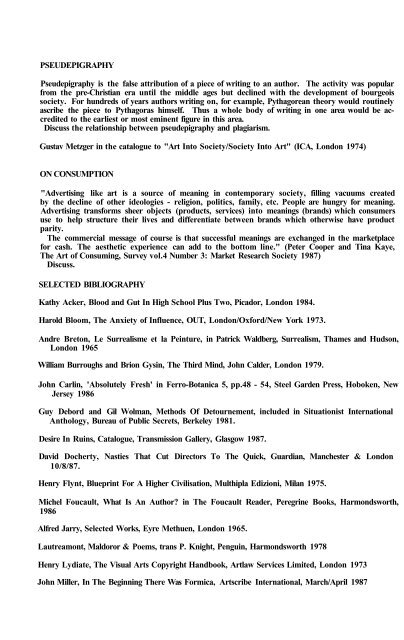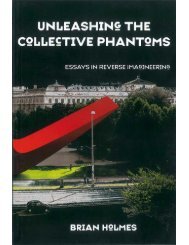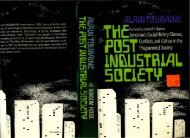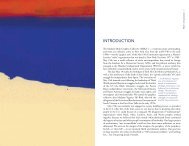Plagiarism: Art As Commodity and Strategies for ... - El plagio literario
Plagiarism: Art As Commodity and Strategies for ... - El plagio literario
Plagiarism: Art As Commodity and Strategies for ... - El plagio literario
Create successful ePaper yourself
Turn your PDF publications into a flip-book with our unique Google optimized e-Paper software.
PSEUDEPIGRAPHY<br />
Pseudepigraphy is the false attribution of a piece of writing to an author. The activity was popular<br />
from the pre-Christian era until the middle ages but declined with the development of bourgeois<br />
society. For hundreds of years authors writing on, <strong>for</strong> example, Pythagorean theory would routinely<br />
ascribe the piece to Pythagoras himself. Thus a whole body of writing in one area would be accredited<br />
to the earliest or most eminent figure in this area.<br />
Discuss the relationship between pseudepigraphy <strong>and</strong> plagiarism.<br />
Gustav Metzger in the catalogue to "<strong>Art</strong> Into Society/Society Into <strong>Art</strong>" (ICA, London 1974)<br />
ON CONSUMPTION<br />
"Advertising like art is a source of meaning in contemporary society, filling vacuums created<br />
by the decline of other ideologies - religion, politics, family, etc. People are hungry <strong>for</strong> meaning.<br />
Advertising trans<strong>for</strong>ms sheer objects (products, services) into meanings (br<strong>and</strong>s) which consumers<br />
use to help structure their lives <strong>and</strong> differentiate between br<strong>and</strong>s which otherwise have product<br />
parity.<br />
The commercial message of course is that successful meanings are exchanged in the marketplace<br />
<strong>for</strong> cash. The aesthetic experience can add to the bottom line." (Peter Cooper <strong>and</strong> Tina Kaye,<br />
The <strong>Art</strong> of Consuming, Survey vol.4 Number 3: Market Research Society 1987)<br />
Discuss.<br />
SELECTED BIBLIOGRAPHY<br />
Kathy Acker, Blood <strong>and</strong> Gut In High School Plus Two, Picador, London 1984.<br />
Harold Bloom, The Anxiety of Influence, OUT, London/Ox<strong>for</strong>d/New York 1973.<br />
Andre Breton, Le Surrealisme et la Peinture, in Patrick Waldberg, Surrealism, Thames <strong>and</strong> Hudson,<br />
London 1965<br />
William Burroughs <strong>and</strong> Brion Gysin, The Third Mind, John Calder, London 1979.<br />
John Carlin, 'Absolutely Fresh' in Ferro-Botanica 5, pp.48 - 54, Steel Garden Press, Hoboken, New<br />
Jersey 1986<br />
Guy Debord <strong>and</strong> Gil Wolman, Methods Of Detournement, included in Situationist International<br />
Anthology, Bureau of Public Secrets, Berkeley 1981.<br />
Desire In Ruins, Catalogue, Transmission Gallery, Glasgow 1987.<br />
David Docherty, Nasties That Cut Directors To The Quick, Guardian, Manchester & London<br />
10/8/87.<br />
Henry Flynt, Blueprint For A Higher Civilisation, Multhipla Edizioni, Milan 1975.<br />
Michel Foucault, What Is An Author? in The Foucault Reader, Peregrine Books, Harmondsworth,<br />
1986<br />
Alfred Jarry, Selected Works, Eyre Methuen, London 1965.<br />
Lautreamont, Maldoror & Poems, trans P. Knight, Penguin, Harmondsworth 1978<br />
Henry Lydiate, The Visual <strong>Art</strong>s Copyright H<strong>and</strong>book, <strong>Art</strong>law Services Limited, London 1973<br />
John Miller, In The Beginning There Was Formica, <strong>Art</strong>scribe International, March/April 1987






